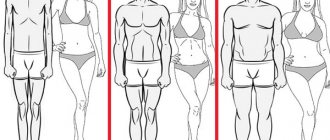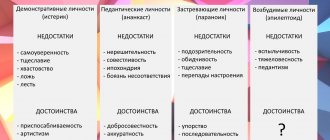General information about types of perception
Dividing people into visual, auditory, kinesthetic and digital in accordance with the basics of neuro-linguistic programming (NLP) allows us to identify their dominant sense organ. At the same time, one predominant sensory perception of the world in a person does not mean suppression of others. People typically have four channels through which they experience the world:
- Visual. With it, a person has a predominantly developed visual system for perceiving the surrounding reality. Color and shape matter to him.
- Auditory. The organ of hearing and the corresponding perception of the world through sounds, timbres, melodies, and volume dominate.
- Kinesthetic. The tactile function predominates. It is easier for a person to recognize this or that object by smell, taste, touch.
- Digital. The logical perception of the world dominates through the construction of an internal dialogue by a person.
The leading channel of a person’s worldview of information allows one to intensify mental activity. Thanks to it, other processes are launched in the form of memory and imagination.
There are several methods for identifying visual, auditory, kinesthetic and digital learners. The main thing is the diagnosis of the predominant modality through testing developed by S. Efremtsev. The test is available online for Internet users who want to find out their dominant type of perception.
Characteristics of auditory, visual, kinesthetic and digital learners include:
- the dominant organ involved in a person’s perception of the surrounding world;
- the influence of the leading channel of perception on character;
- correlation of the type of perception with a person’s personality type;
- a set of differences between one form of human assessment of the surrounding reality and others.
How to determine whether your child is kinesthetic, auditory, visual or discrete?
How to determine kinesthetic, auditory, visual
or
your child
discrete When a child is born, he already has innate characteristics and his character is unique. Each child is unique and individual. In order to choose the best method of raising, developing and teaching a child, you need to know a number of features that are inherent specifically to him. You need to know as much as possible about its characteristics and interests. Maybe your child likes to draw more? But he doesn’t want to put together puzzles and solve complex problems. Thus, we can say that each child requires an individual approach; you need to decide: who is your child?
School learning for a child is mainly a process of perception and assimilation of the information offered.
Depending on the characteristics of perception and processing of information, people can be divided into four categories:
- Visual learners are people who perceive most information through vision.
- Auditory learners are those who primarily receive information through the auditory canal.
- Kinesthetics are people who perceive most information through other senses (smell, touch, etc.) and through movements.
- Discrete people - their perception of information occurs mainly through logical comprehension, with the help of numbers, signs, and logical arguments. This category is perhaps the smallest among people in general. But for elementary and middle school students, this way of perceiving information is usually not at all typical.
How to determine whether your child is kinesthetic, visual or auditory? To do this, you can take a special psychological test.
TEST
“Auditory, visual or kinesthetic”
1. What toys does your child prefer to play with?
A. Toys that make various noises and sounds, including musical instruments. Likes to listen to music and fairy tales.
B. Board games, plasticine clay, drawing supplies, books with colorful pictures. Loves to sculpt, draw, cut out and put together puzzles. Activities and games that rely on the interaction of eyes and hands.
K. Soft toys, construction sets, homemade games. Everything that can be taken apart, crushed, bent. Loves to paint, glue, and make things.
2. How do you feel about what he is wearing?
A. It doesn’t matter what kind of clothes. It happens that he won’t wear something that someone said badly about.
B. Carefully selects her wardrobe. Loves to dress up.
K. He likes warm, roomy things. Prefers familiar and comfortable clothing that does not restrict movement.
3. How does he express feelings and love for his family?
A. In words. He may not even look at you.
Q. Personal eye-to-eye contact is important, it is necessary to see your face.
K. Physical contact is needed - hugs, kisses.
4. What does he like to do?
A. Listen to music, talk, make noise.
V. Taciturn, prefers to watch others. He likes to watch TV and look at pictures in books.
K. Loves outdoor games and sports. Energetic, cannot concentrate on one subject for a long time.
5. What does he prefer to play?
A. Enjoys inventing and organizing games and assigning roles. But if outdoor games are planned, it quickly cools down.
B. Can study on his own for a long time. Before he starts playing with other children, he needs to take a closer look at what they do and how they do it.
K. Loves active games with jumping, running, wrestling.
6. How does he behave when he is worried or afraid?
A. Shudder at every sound, listens to footsteps.
B. Adjusts his clothes as if they were wrinkled or dirty, tries to smooth them out and shake them off.
K. Constantly fiddling with his hair or fiddling with something in his hands.
7. Favorite teacher or teacher - most likely this is:
A. A woman with a pleasant voice.
V. The most pretty and beautifully dressed.
K. The one that smells nice, that you can touch, hug.
8. What distracts him the most in class?
A. The neighbor mumbles something under his breath all the time.
Q. It’s interesting to look out the window.
K. Uncomfortable hard chairs, rough desk.
9. How does he speak?
A. Speaks quickly. Emotional, sociable, verbose, often chatting to himself.
B. Speaks slowly. Speech is figurative, in conversation he paints “living pictures” for the interlocutor.
K. Speaks rhythmically. Rich gestures, many “sensory” epithets.
10. What words does he use most often?
A. Listen, rhythm, sounds, speak, be silent, loud, quiet, calm.
B. Look, see, observe, bright, picture, light, dark.
K. Grab, feel, touch, experience, hold, press, warm, cold.
11. Does he like to read?
A. He listens with great pleasure to others reading to him.
V. He reads avidly.
K. I would prefer to play something.
Analysis of questionnaires.
MORE "A's". AUDIO
These children remember in great detail who said what, where, when, and in what words. They instantly “grab” first names and patronymics, but easily forget faces. Their greatest pleasure is conversation; they will never be interested in a book if they have someone to talk to. All secrets and news immediately become known to them. No, they are not specifically trying to find out what you are talking about, it’s just that their hearing is much better developed than others. Auditory children have a large vocabulary, but may lag slightly behind their peers in the development of skills related to visual (finding differences in pictures) and motor (the ability to deftly climb a slide, run quickly and for a long time) perception.
In their speech, auditory learners often use the words “listen”, “hear”, “noisy”, “quiet”. Such children think through internal speech, mentally pronouncing their own remarks and the interlocutor’s answers, assuming what kind of voice he will have, what intonation. They love the radio. They like television programs that are dominated by “words” rather than “pictures.” They are very attentive in conversations. In a conversation with an auditory speaker, it is useful to use vocal features: pauses, intonation, volume.
In primary school, auditory learners often study well; their strength is developed auditory memory and speech, but they often have difficulties with spelling and drawing. In middle school, auditory learners who are accustomed to using their memory usually demonstrate significantly less success. During this period, you should pay more attention to reading, pronouncing, and repeating the rules out loud. Auditory learners are musical and easily grasp foreign languages. They are recommended to use audio materials first. When doing homework, such children may move their lips and talk to themselves. Another feature of auditory learners that is associated with difficulties at school is the ability to tell only from the very beginning.
MORE IN". VISUAL
Visual learners instantly remember faces, but often forget first and last names. They easily find their way even to places they have only been to once. The speech of visual children is filled with the words “look”, “have you seen”, “beautiful”, “bright”, “red”, “green”... They think in images. In the process of thinking, pictures from the past, ideas about the future, images appear in their heads, imaginary situations are played out - like in a movie (little visual learners have a wild and vivid imagination).
Visual children hate hugs, kisses, and baby talk, but will happily talk to you about adult topics (at arm's length). They usually look older than their age because they keep themselves aloof and a little arrogant. They love to lecture their elders and quote phrases “from TV,” which they adore. They sense your mood and desires by your facial expressions, but do not always let you understand this (of course, in their own interests). Visual learners have excellent visual memory and fine motor skills are well developed, but they have difficulty understanding verbal instructions and often repeat tasks. Quickly remembers color, shape, size. They find it easy to tell stories based on pictures. Their eyes are always searching for information.
Children who are visual learners begin to write in block letters early and can read quite fluently by the time they reach school. In raising a visual student, it is necessary to pay attention to the development of speech (he is taciturn), sociability (the ability to communicate), and physical coordination. Visual learners - schoolchildren remember the teacher’s explanations more easily if they are duplicated on the school board or on diagram posters: it is easier for them to see and visually remember the word than to understand the rule why they should write it that way. Visual aids, illustrations, the use of colored pencils: sketch, reproduce, highlight - all this contributes to better assimilation of the material.
Allow your child to use colored pens to highlight important points in the book. As visual learners, it is vital for them to have a draft in which they can draw and draw.
MORE K's. KINESTHETIC
During a conversation, kinesthetic learners make a lot of movements and gestures, stand close to the interlocutor, but rarely look into the eyes. Such children cannot sit in front of the TV for a long time and most often do not like the theater. But they love to tinker, fight and organize various competitions. A kinesthetic child will never listen to a story before bed if you don’t stroke or hug him. He is attached to his parents, especially his mother, does not leave his arms for a long time, and even at primary school age loves to climb onto his parents’ laps.
He should be kissed and hugged more often. When you say “well done” to your baby, don’t forget to pat him on the head or hug him close.
In the speech of kinesthetic learners there is a huge number of quality adjectives. When describing a favorite toy, a child is more likely to say “soft fluffy bear” than “brown bear.” Such children often use the words “feel”, “feel”, “hot”, “cold”, “pain”, “hard”, “soft”. Kinesthetics have well-developed intuition. Reading causes a feeling of discomfort: there is nothing to occupy your hands, your fingers languish from inactivity, your legs crave movement. They often begin to write earlier than to read, so they need to be taught reading through writing. Often, when they try to write, they run their fingers over the text.
They say about kinesthetics that they “look with their hands.” It doesn’t matter that children’s toys of this type are short-lived: by taking them apart, they learn about the world. They find it difficult to sit still while doing one thing. They cannot concentrate attention on one object for a long time. At school, such children learn the material much easier if learning is accompanied by practical work: they need to touch, fold, assemble, construct, smell, even taste something that will then become a source of knowledge. They like to write down everything; if they only listen or watch, they will not perceive even half of the information. But these children are amazingly literate.
The educational process for a child is the perception and assimilation of the proposed information. However, the question arises why some children grasp this information on the fly, while others cannot learn it even after repeated repetitions. The fact is that each child has individual characteristics of perception, therefore, it is necessary to build the educational process taking into account these characteristics.
How to create good conditions for learning for an auditory child?
- it is necessary to create a calm atmosphere for the child so that extraneous sounds do not distract him from his activities
- Such children like to listen more than to write down, so they need to read a textbook or additional literature for better assimilation of the material
- it’s good when your child tells everything that he understood and learned in class
- You can buy a voice recorder for your child so that he can record his voice; this device can be useful in further studies at the University
- let your child listen to audio books
- you need to teach your child to pronounce his actions when writing a dictation, for example, out loud at home and in a whisper in class.
How to create good conditions for learning for a visual child?
- Visual learners need a lot of space and time to learn. Therefore, you need a large table, as well as various stickers, markers, pencils, bookmarks, etc.
- need a magnetic board or chalk board
- You can buy educational posters for your child and let him place them on the walls himself
- you need to buy textbooks with a lot of tables and graphs and clear explanations of the rules.
How to create good conditions for learning for a kinesthetic child?
- it is necessary to provide the child with the necessary set of materials and create conditions for practical exercises at home
- for better assimilation of the material, you need to give examples from life
- the child is interested in large encyclopedias, where he can find answers to any questions
- You can watch educational films and TV shows together
- you need to visit museums, exhibitions, and excursions more often
Recommendations
Each type must be approached individually in any activity, including academic work.
- Experts say:
- a visual person can be required to quickly solve problems;
- from auditory - immediate repetition of the material he heard;
- It’s better not to expect either one or the other from a kinesthetic learner - he needs a different attitude, he needs more time and patience on the part of teachers and family!
— When doing work in class or at home, it is recommended:
- allow the visual student to have a piece of paper at hand on which, in the process of comprehending and memorizing the material, he can draw, hatch, draw, etc.;
- the auditory learner should not make comments when he makes sounds or moves his lips during the process of memorization - this makes it easier for him to cope with the task;
- kinesthetics do not force one to sit still for a long time; be sure to give him the opportunity for motor discharge (go for chalk, a magazine, write on the board, at home - go to another room, etc.); Memorizing material is easier for him while moving.
— Of course, it is very important to communicate with the child in “his language”:
- with the visual using words describing color, size, shape, location; highlighting different points or aspects of content with color; recording actions using diagrams, tables, visual aids, etc.;
- with the auditory using voice variations (loudness, pauses, pitch), reflecting the rhythm of speech with the body (especially with the head) at a speed characteristic of this type of perception;
- with a kinesthetic person using gestures, touches and the typical slow speed of thought processes; remember that kinesthetic learners learn through muscle memory; the more exaggeration, the better for memorization; allow them to role-play parts of your information.
— Yes, and a remark to a child will have the desired effect if it is made “in his language”:
- it is better for the visual to shake his head and wag his finger;
- for the auditory - say in a whisper “sh-sh-sh”;
- kinesthetics - put your hand on your shoulder, pat it.
— Any person, including a child, uses different channels of perception
, that is, we cannot be only visual, for example. Peculiarities of perception also depend on age: young children tend to want to touch and taste everything, while schoolchildren more often use their hearing and vision. The organs of perception can and should be developed. The more channels are open for the perception of information, the more effective the learning process is.
— Learn to understand each other
, then there will be much fewer problems in your life and in the lives of your children!!!
Based on the characteristics of visual, kinesthetic and auditory learners, you can determine what type your child belongs to and help him cope better with tasks at school. And also understand why he is interested in this particular thing and not another. Now you can understand each other better! Children are visual, auditory and kinesthetic learners so different, but at the same time so similar - after all, we still love them very much.
Characteristics of visuals
Auditory, visual, kinesthetic, and digital learners differ from each other in character, method of communication, and external signs. A feature of visual people is their perception of the world through visual images. Their dominant sense organ is their eyes. At the same time, other forms of assessing the world are no less developed in such people, but it is easier and more convenient for them to process incoming information through vision.
You can identify a visual person by their characteristic facial expressions. It serves as its distinctive feature. Much is determined by a person’s gaze:
- directed upward and to the left when trying to remember any information;
- up and to the right when fantasizing;
- straight and into the distance during mental activity.
These signs are typical for people with a predominant visual channel of worldview. By the look of a visual person, you can determine whether he is telling the truth or lying.
Interesting! A visual learner who is trying to tell a lie looks up and to the right when asked a specific question.
Visuals are characterized by the following features:
- perception of information through images;
- pronounced gestures;
- using the words “see”, “notice”, “it seems to me”, “take a look”, “look” when speaking;
- perception during the learning process only of visual information in the form of graphs, diagrams, drawings, photographs, experiments;
- paying attention to the appearance of other people, their facial expressions, gestures, postures;
- good imagination.
For a visual person, appearance is important. He is receptive to everything he sees. Such people appreciate the beauty of the world and its individual objects. They do not like dirt, sloppiness and disorder. If a child is a visual learner, then during the learning process he will better assimilate information presented to him in schematic and illustrated form.
People of this type master speed reading faster than others and perceive information better in the form of text. Visual learners are also characterized by visual memory. They remember the location of objects better than others and are well oriented in the area.
Visualists prefer to keep their distance when talking to other people. A comfort zone is important to them. Moreover, the distance between them and their interlocutors should be at least one meter. The gaze of visuals wanders and is in search. To successfully complete their tasks, such people need clear diagrams, visual pictures and images.
Characteristics of auditory people
For this type of perception, information received through the organs of hearing is of particular importance. An auditory learner can be called a person who better assimilates material read aloud. This is especially important for schoolchildren. Auditory children remember well only information that was presented to them by the teacher orally.
The following characteristics are characteristic of audio:
- the use of “auditory” phrases in speech (“I heard”, “I can’t understand”, “tell me”, “I heard it”, “listen to me”);
- good perception of music, conversations;
- good hearing;
- the need for complete silence when concentrating on something;
- high demands on both one’s own and others’ speech;
- great love for music;
- sensitivity to conversations;
- good auditory memory.
Attention! When talking to an auditory learner, it is important not to raise your tone or shout, as this will make him or her dislike your interlocutor.
People of this type are considered good storytellers. They prefer to discuss any issue with others. This way they learn any material better. Auditory learners are more focused on communication than others. This is one of the most sociable types of people.
Auditory learners are worse than others at remembering people's faces and are not always well oriented in space. But they recognize a person by his voice better than others. You can identify such people by their gaze. For them it is usually directed either to the right or to the left.
Auditory learners are less prone to conflicts than others and more often prefer not to raise their voices. Their speech is usually even, and their speech is measured and calm. A common profession among auditory learners is musician. Given their sociability and ability to conduct a conversation, such people achieve success in work related to public speaking.
For the auditory, only a specific fact without unnecessary details matters. It is important for him to have contact with a person who has a pleasant timbre of voice for him. They pay less attention to people's appearance, being guided mainly by auditory sensations.
How to recognize an auditory child?
An auditory child is immersed in an ocean of sounds. He loves to talk and argue, composes incredible stories, subtly captures intonations, loves music and often hums to himself, easily memorizes poetry and expressively recites his favorite poets. During lessons, auditory children try to be attentive, but are easily distracted by noise and therefore need peace and quiet. Personal attention is very important to them, so they sometimes seem intrusive.
Auditory learners learn well from audiobooks and in lecture format - they quickly memorize and accurately reproduce the material, managing not only to grasp the essence, but also to delve into the details, and draw original conclusions from what they hear. Effective memorization is facilitated by rhymes, repetitions, and reading aloud.
Typical problems of an auditory child are difficulties with spelling and reading, absent-mindedness and forgetfulness. To improve concentration skills, children are encouraged to verbalize their actions. It is useful to take mental arithmetic courses so that internal concentration becomes a habit and does not cause tension.
Rules for teaching and raising auditory children
- Create a separate corner at home for your baby, where extraneous sounds will not penetrate. In this case, it will be easier for him to concentrate, and he will be able to play calmly and study productively.
- If your child prefers to listen to you rather than read for himself, don’t insist otherwise.
- Pay attention to your speech. Your son or daughter will understand you better if you pause, color your words with intonation, and highlight the main thing with your voice.
- Buy audiobooks for your baby, listen to music with him, not necessarily classical.
- Give him a voice recorder. It may be useful when studying at school.
- To make it easier for your child to do something, teach him to say the sequence of actions first out loud, and then to himself.
- If a child wants to learn a foreign language, pay great attention to conversational practice.
Description of kinesthetic
Such a person can be identified by a number of signs:
- frequent use of words with a pronounced emotional connotation (“excited”, “goosebumps”, “I’m delighted”);
- frequent touching of the interlocutor;
- close distance with a person when talking;
- restlessness;
- emotionality;
- better assimilation of information through movement and touch.
A kinesthetic learner understands the world well through personal experience. He prefers practice to theory. At the same time, it is important for him to take direct part in the process. People of this type are more focused on taste and smell than others. It is important for them to personally touch or try the item in order to draw the necessary conclusions.
Kinesthetic learners are active people. They can be given a precise definition. These are workaholics who do not tolerate inaction. Kinesthetic people do not have good attention; they have difficulty concentrating on anything for a long time. For this reason, they do not like routine and monotonous work.
Kinesthetics have a special psychological portrait. Despite the desire of such people to be at a minimum distance from the interlocutor during a conversation, they are selective in communication. A kinesthetic person can only let someone close to him who has won his trust.
Interesting! For a kinesthetic learner, the violation of his personal space by a stranger is especially offensive. This cannot pass without a trace for him.
Like visual people, people of this type do not perceive oral information well. It is easier for them to explore the world through visual data and through personal contact. For a kinesthetic learner, it is physical contact with a loved one that is important. Comfort has a major impact on it. Any inconvenience provokes severe irritation in the kinesthetic student. Such people love conversations related to feelings and sensations. Emotional exchange with the interlocutor is important for them.











